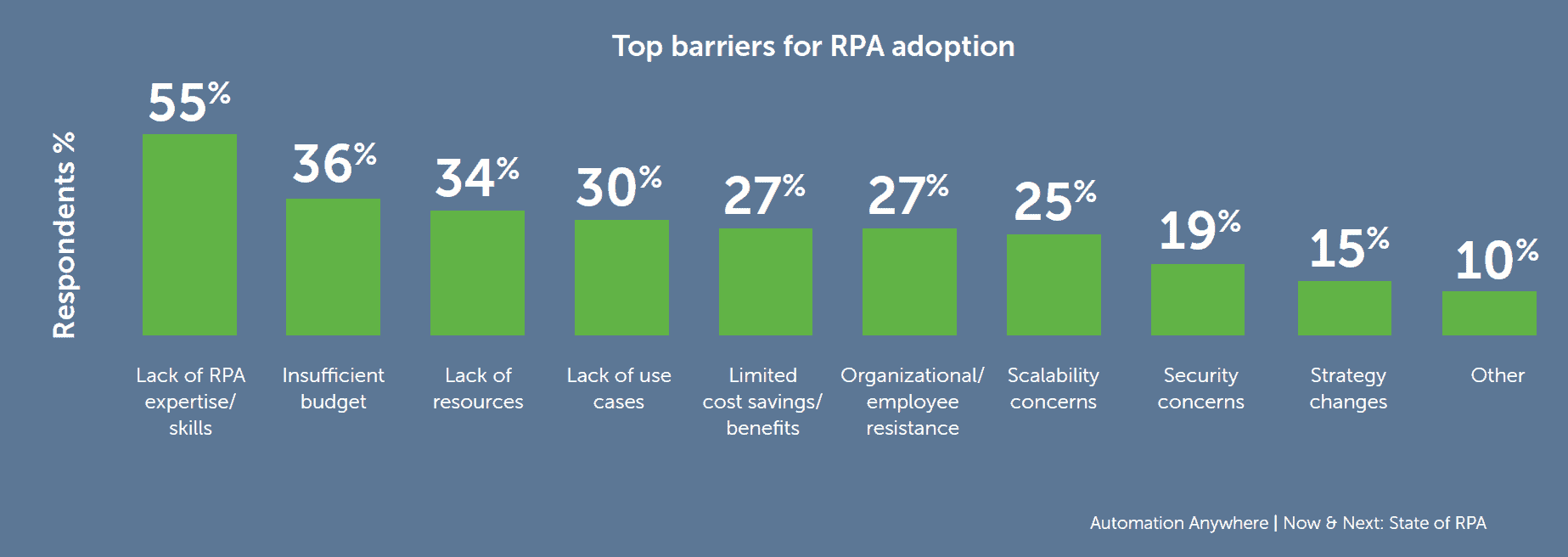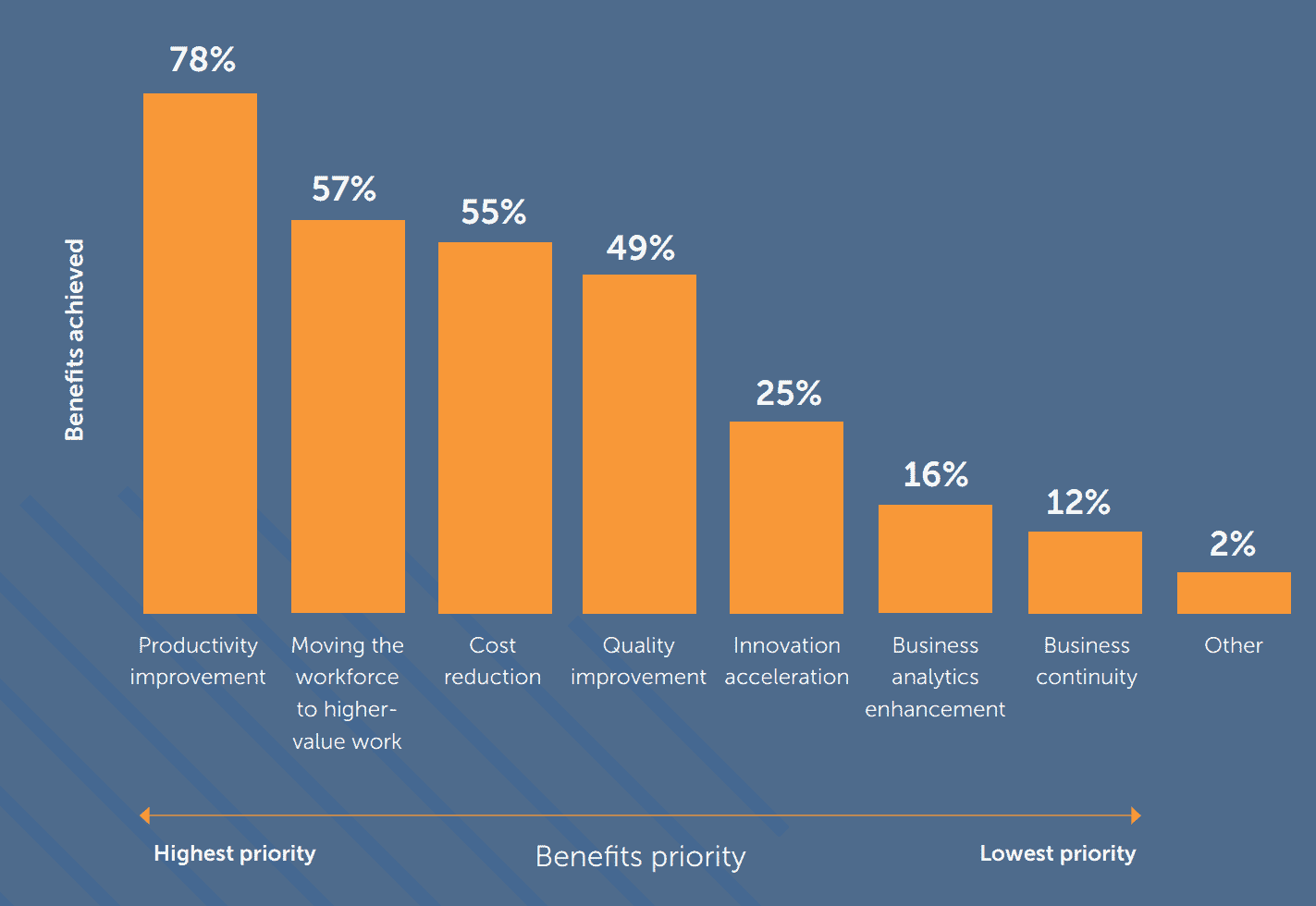The Next Era of Robotic Process Automation
Robotic process automation (RPA) solutions greatly impacted businesses for the better in 2020, seeing an average 250% ROI. Now more organizations and industries are interested in and investing in RPA technologies as the workforce’s productivity and time are the highest priority.
The next era of robotic process automation (RPA). What? You didn’t realize we were already finished with the first era? Where has the time gone? We haven’t even finished educating the world’s businesses on what RPA is before we’ve moved on to the next era. Such is digital transformation – it moves forward, with or without you.
We’ll continue to help others that are still at Step 1, “What is RPA,” or the crawl phase, for quite some time. Additionally, we’re providing educational information around getting started with RPA. However, for many organizations over the last 3 years, we have seen the transformation from “What is RPA,” to “Show me what it means to our processes,” and finally to “Let’s add more bots.”
If 2020 was the year that RPA was expedited to relieve the sudden burden of staff reduction, 2021 will become the milestone for many when they officially embrace RPA for long-term outcomes.
Combining Smartbridge’s experience with some of the latest research, here’s how we define the next era of RPA:
WHO is implementing RPA?
Our most recent deployments have been in restaurants/food service, commercial real estate, and property management. Facility management, durables manufacturing, and construction are picking up speed as well. In a report released in January 2021 by Automation Anywhere, respondents said they were evaluating and deploying RPA solutions in financial services, life sciences, and others.
of organizations are either deploying or actively scaling their RPA efforts
of organizations are still evaluating RPA
of organizations have no plans at this time
Large to enterprise-sized businesses are well-positioned to invest in deploying 1 to 10 bots, owning their own licenses, and bringing on a professional services partner. Small to medium-sized businesses may struggle to find the funding to test the waters. However, a newer option in the market may be RPA-as-a-Service, which reduces or eliminates the up-front costs.

Image courtesy of Automation Anywhere
WHERE is RPA being deployed within organizations?
Finance and accounting are going full speed ahead with some simple-to-medium complexity bots. This means that they are using RPA bots for business processes that typically include reconciliations, journal entries, or process vendor invoices. Hours saved is usually a huge benefit realization that keeps accounting adding more bots, and in turn, they are reallocating their team to more creative work and taking on new challenges.
Salesforce is even progressing into RPA for their own internal finance processes! The secondary wave of RPA adoption appears to be within Sales, Operations, Human Resources, and Compliance.
In a recent Forbes interview, the CFO of La-Z-Boy, Melinda Whittington, shared insight into just how automation has expanded the role of the CFO.
I often say the CFO’s (or any finance leader’s) role is to understand the business as well as the CEO, but then also understand everything behind the numbers! […] Leveraging continuous improvement and technological enhancements, like robotic process automation, are imperative to improving efficiency and enabling resources to take on new challenges.
– Melinda Whittington, CFO of La-Z-Boy
WHY are they investing in and implementing RPA?
The number one reason organizations are starting their RPA initiatives or have already deployed them is productivity. The time and effort it takes to complete mundane, repetitive tasks could be reallocated to higher-value projects where human creativity and collaboration can flourish. For those organizations that implemented RPA solutions, they saw increased benefits with what they were able to now achieve.

Image courtesy of Automation Anywhere
ROI was the other main contributing factor for organizations to deploy RPA technologies. For the respondents of the 2021 Automation Anywhere report, these organizations had an average 250% ROI 14 months after their initial RPA investment. When factoring in productivity, quality improvements, cost-cutting, and increased time for higher-value work, there were measurable returns on average 2.5 times the overall RPA investment amount.
WHAT is everyone automating?
The core purpose of RPA is to take away mundane repetitive tasks and reduce the chance of human error. This allows for the human workforce to shine on the creative, challenging, and complex work that everyone brags about on LinkedIn. Here are a few places where we have seen bots make a sizable impact:
HOW are organizations implementing RPA successfully?
A leading reason why many businesses don’t consider RPA, or move forward after a pilot, is due to a lack of skills, experience, or a seamless methodology. Many companies have been burned by RPA technologies simply for the lack of having the right team in place.
In this new era, there are plenty of places to go that will provide the best practices and methodologies learned from previous engagements. There’s no need to reinvent the wheel at this point. Yes, your pilot will likely have custom requirements, but there are a few key pillars to project success.
The Key Pillars for an Optimal Foundation:
The process begins with collaboration and training by starting a Center of Excellence(CoE). At the beginning, this may seem premature, but most successful stories we’ve encountered included the establishment of a CoE early in the process. Executive awareness, business analysts, developers (from citizen to expert), and infrastructure engineers play a key role.
Having the right partners is instrumental. Automation Anywhere released a study that said, “ROI correlated highly with a key number of vendor selection parameters.” Your RPA software vendor(UiPath, Power Automate, etc.) and your services partner(such as Smartbridge) must be the best fit for the processes you intend to automate, the in-house staff in to maintain the bots, and provide methodologies that work for you. In RPA, the saying especially rings true: you get what you pay for!
The biggest stumble that leaves people thinking RPA isn’t all it’s cracked up to be is not implementing best practices and proper change management. Automating what never before has been automated isn’t like flipping a switch. But once you get the cadence down and nurture a sustainable program, RPA will have a lasting positive impact on your organization.
Looking for more on Automation?
Explore more insights and expertise at Smartbridge.com/automation
Keep Reading: The Advantages of Automation in Business
There’s more to explore at Smartbridge.com!
Sign up to be notified when we publish articles, news, videos and more!
Other ways to
follow us:




